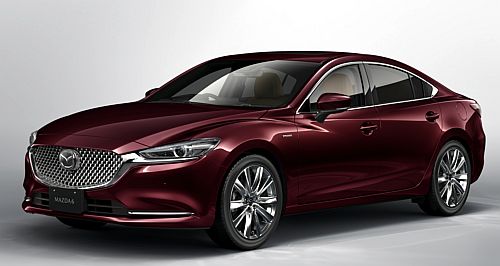Make / Model Search
News - MazdaMazda defends age of some productsAustralia’s second most-popular brand says old products are not holding it back6 Feb 2024 By TONY O'KANE THE average punter could be forgiven for thinking that certain corners of the Mazda product portfolio look somewhat aged – because they are.
Having gone on sale in 2012, the current Mazda 6 is the oldest in the showroom, its 12-year production run roughly double the typical lifecycle of a passenger car.
Despite being the recipient of two facelifts and the application of the CX-9’s 2.5-litre turbo-petrol four-cylinder, the core Mazda 6 offering has not evolved significantly in that time.
Meanwhile, the DJ Mazda 2 celebrates its tenth year on the market in 2024. A facelift that arrived late last year tweaked the specs and cosmetics, but beyond price creep taking the compact hatch well over the $20K barrier the Mazda 2 is, like the Mazda 6, not all that different to the car that launched here way back in the first half of the 2010s.
But the CX-5 is potentially most concerning. Now in its seventh year of production, the KF CX-5 is still working beyond the age of retirement – and with it providing nearly a quarter of Mazda Australia’s sales last year, it is doing much of the heavy lifting.
Should buyers begin to regard the CX-5 as a bit old hat, it could threaten Mazda’s position as the second highest-selling brand in this country.
The CX-3 is in a similar position. It launched in this market nine years ago, has not evolved in any great way, and little has been said about what will replace it. Yet like the CX-5, its age does not appear to have wilted its sales figures.
For its part, Mazda Australia does not seem too concerned by the age of its older models.
Mazda Australia marketing director Alastair Doak told GoAuto that while the industry standard is to build two generations of vehicle off a single platform iteration – the second of which could be seen as more of a wholesale facelift rather than an entirely new generation – Mazda’s approach with the 2 and the 6 has been to keep the top hat the same for the entire lifespan of the platform beneath it.
That approach is understandable given the waning popularity of passenger vehicles and the status of Mazda as a relative minnow in the global auto industry, as forgoing a full generation for the 2 and 6 would have undoubtedly freed up development dollars for its SUV products.
For example, the current KF CX-5 is, in essence, an evolution of the KE generation that preceded it, and utilises much of the same under-the-skin hardware.
Keeping that nameplate fresh at the expense of a slower-selling mid-size passenger car and substantially less profitable B-segment hatchback would no doubt have been a commercial imperative.
But there is no getting around the fact that Mazda has an age problem. The CX-60 and CX-90 are fresh-faced and full of potential, but almost everything beneath them is either overdue for replacement with nothing in sight, or rapidly approaching that age with few hints about what lies around the corner.
The CX-30 and Mazda 3, both platform-mates, celebrate their fifth birthday this year, but it remains unclear if Mazda will renew them in a significant fashion or – like the 6, 2, and CX-3 – ask them to soldier on for a double-shift.
From an outside perspective, it almost appears like Mazda is waiting for an opportune moment to dramatically shift the paradigm on those vehicles, and will time their full-model changeovers for when that moment comes.
Is Mazda holding back on model renewals in anticipation of an electrified makeover, just like Renault has done with the Megane E-Tech and Nissan will do with the Micra?
Mazda Australia managing director Vinesh Bhindi would not get specific, but indicated that electrification would play a big role in the model renewal program.
“The thing we have to keep in mind is there is a potential landscape change with electrification, and by the end of this decade I think the landscape of what we believe was ‘traditional’ might look a little bit different,” Mr Bhindi told GoAuto.
“Yes, there will be all versions of cars available, but at this stage for Mazda Corporation … Building electrified technologies, powertrains, is the priority. Once you have that, which cars do you pair it up to? It opens up a lot of opportunities.”
Mr Bhindi also maintained that the brand will not simply let its smaller vehicles wither on the vine while it focused on its new Large Product portfolio.
“We’re not going to be a company that, globally, just has large platform products,” he said.
“We have the small platform as well, which is for things like the Mazda 3 and so forth, but we’re also working on a scalable architecture platform, which will be the next one. We plan to have products using all of those platforms and having multiple products to have choice for Australian consumers.
“It just so happens that at this stage Mazda Corporation’s R&D product cadence is focusing on the large platform, but our plan is to remain relevant in a lot of segments,” Mr Bhindi continued.
“Right now the only one that Mazda Corporation has officially acknowledged and confirmed is that there’s going to be a next-generation ‘CX-5 type’ vehicle.
“What that will be called is open to debate, but there will be a replacement for CX-5 and then there’ll be other new models and replacements – but those are something we can’t delve into right now.”  Read more31st of January 2024  CX-70 revealed as third premium SUV for MazdaMazda introduces an in-betweener SUV to bridge the gap between the CX-60 and CX-906th of November 2023  2023 Mazda CX-5 Akera Skyactiv-D ReviewNow defunct diesel-powered CX-5 a pleasure to drive, with a strong, smooth and economical engine31st of October 2023  Mazda discontinues CX-8 and MX-30Aus-bound Mazda CX-8 and MX-30 production ends next month ahead of 2024 CX-80 reveal14th of August 2023  Mazda won’t abandon affordable modelsPremium push won’t push cheaper Mazdas out, says Mazda Australia boss |
Click to shareMazda articlesResearch Mazda Motor industry news |











Facebook Twitter Instagram